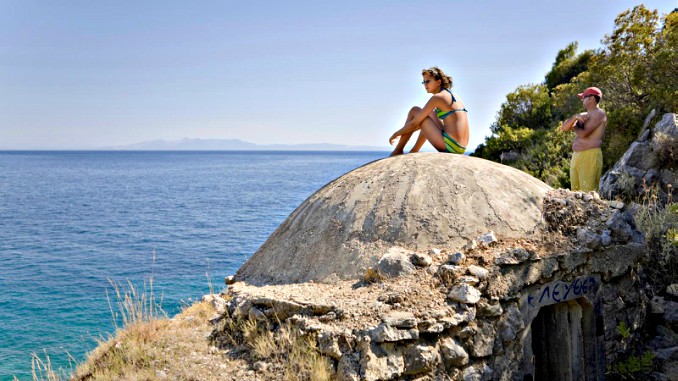
Eric Czuleger says for Ozy.com that people should always care because paranoia can take many forms, including the bunkerization of an entire country, like the case of the small Balkan country of Albania.
It was a common scene in Tirana, the eastern Mediterranean capital of Albania — hundreds of people assembling in Skanderbeg Square, men and women dressed in olive-green partisan uniforms emblazoned with red Soviet stars as if they’d just come from a war. Or were on their way to one.
At just such gathering, graying dictator Enver Hoxha announced an aggressive military policy that would impact the lives of every man, woman and child in the tiny Balkan country. The leader who had ruled Albania with an iron fist since 1944 was about to prepare his homeland to defend itself against invasion on all fronts with a strange strategy — bunkerization.
Starting in 1967, construction of round-topped concrete bunkers continued unabated for the next 20 years until the mushroomlike strongholds sprouted along beaches and borders, atop hills and mountains and throughout fields and forests. Though the exact number of gray pods is unknown — estimates range from 500,000 to nearly 750,000 — the bunkers stand as monuments to the years that Albanians lived in complete isolation from the rest of the world.
There were two main reasons Hoxha decided bunkerization was necessary, according to Tritan Shehu, Albania’s former minister of foreign affairs. Construction of the bunkers was connected intrinsically with the regime’s paranoia about the intentions of the Soviet bloc and its equally deep-seated suspicions of the non-Communist world. “So it was a reaction that expressed the uncertainty that a criminal has when growing up in a civil environment,” Shehu says.
Hoxha was a devout Stalinist, an isolationist and an atheist. The state was the religion, and labor was often considered worship. Githmone gotti — “always ready” — was a common phrase in Hoxha’s Albania. The construction program added to that “psychology of fear” among the population, says Shehu. It became “necessary for Albanians to look like enemies to all who lived abroad, as well as anyone who did not like the domestic regime.”
The regime’s military defensive strategy was guerrilla warfare designed to defeat a more powerful invading force. Large bunkers squatted on hilltops with smaller bunkers radiating outward and connected via a network of tunnels that burrowed through the Albanian countryside. “Defense lines start with the individual and collective positions of machine guns, then cannons and heavier artillery,” Rrahman Parllaku, a former high-ranking Albanian army veteran of World War II and the Kosovo War, told Elian Stefa and Gyler Mytydi, authors of Concrete Mushrooms. “Within infantry positions there are also gunmen, which provide firing support for the first and the second lines of defense.”
There was a historical precedent for this military philosophy. Albania’s landscape allowed it to fight the Ottoman Empire during five centuries of occupation, as well as thwart Italian and German attempts to control the country during World War II. With hundreds of thousands of bunkers peppering the countryside, Hoxha’s Albania was prepared to defend itself from the world.
But how did Hoxha become so crippled with paranoia that he had to fortify his nation? Hoxha had not made many friends in his time as leader. The Soviet Union parted ways with Albania after it sided with China during the Sino-Soviet rift. Conflict still simmered between Albania and Greece, its neighbor to the south. What was then Yugoslavia flanked it to the north and east, and relations were strained between Yugoslavian strongman Josip Broz Tito and Hoxha, who accused Tito of persecuting Yugoslavia’s Kosovar Albanian minority.
Despite the tensions of the era, war never came during Hoxha’s regime, which ended with the leader’s death, in 1985. The bunkers were never used as designed.
Thirteen years later, though, they finally saw action. Yugoslavia had broken in 1989, and its rump republics, Montenegro and Serbia, battled the Kosovo Liberation Army in 1998–99. The KLA used the bunkers as defensive positions along Albania’s border with Kosovo. The Serbian military responded by bombarding the concrete dugouts with artillery, even as refugees from the conflict sought shelter there.
Since then, most of the bunkers have fallen into disrepair, though many still crouch in mountain passes and along highways. Entrepreneurs have transformed some into hostels, shops and restaurants. “The future of the bunkers will be their destruction,” says Shehu, “and the liberation of the territories from them.” Though some people believe the nation should preserve the bunkers for their significance to Albanian history, Shehu disagrees. “The bunkers do not serve anyone,” he says. “They damage the territory and create pollution as well as bring up hideous memories of the past.”
Source: OZY.COM